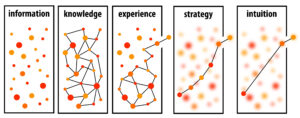While it’s never a good idea to lead by emotions, it’s a fantastic idea to lead by understanding them.
Emotional Reasoning helps leaders determine how they feel about different options when making decisions, in addition to facts and data.

What is Emotional Reasoning and why is it important?
Humans aren’t machines. We’re made up of both emotion and reason. While it doesn’t serve us to make emotional decisions based solely on how we feel, we also aren’t meant to look at situations only through the lens of data and facts.
Emotional Reasoning is exactly that—the ability to combine information from feelings with technical data and facts. It tells us how to balance emotion and reason to solve the kinds of complex problems that we as leaders face every day.
When you are strong in Emotional Reasoning, it means you:
- Fully understand the different ways emotions influence people’s behavior and reactions
- Predict which emotions can come up in certain situations and factor this into your problem solving
- Have deep knowledge of what emotions are, where they come from, and how they fluctuate
- Know which issues need more technical information before coming to a decision, and by contrast, which require more emotional attention
How to lead through Emotional Reasoning
Here are some excellent ways to start incorporating Emotional Reasoning into your everyday leadership right now:
- Learn to treat emotions as insight—Emotions contain important information. For example, if a colleague is feeling frustrated or stressed out, that gives you valuable insight into how likely they are to accept new ideas and information. You can use that to decide how you will present such matters to them.
- Pay attention to your body—How many times have we kicked ourselves for not “going with our gut”? This proves emotional data is a real thing. It must be taken into consideration for decision making the same way we do with numbers and facts.
- Put yourself in their shoes—Consider different perspectives of a situation. A good way to do this is to integrate input from multiple stakeholders. Diversity of thought always enhances decision making.
- Be aware of biases in your decision making—We all have biases, even if we’re not aware of them. Ask yourself if you are truly thinking about an issue objectively, especially primarily when you feel overly emotional about it.
- Be consistent with your organization’s values—When data alone does not seem to provide all the answers, go back to values as a guiding principle when making important decisions.
- Take the extra time—To communicate to your colleagues and team your rationale and thought process behind your decisions. Help them understand the emotions and the facts that went into it, and why you found them valuable.
Benefits of being a leader who uses Emotional Reasoning
- Make well thought-out decisions—Emotional Reasoning adds a creative depth to the basic facts and data of the decision-making process. You’ll notice your decisions are more expansive, and resonate with others.
- Better trust your gut—In some cases, you’ll need to make on-the-spot decisions without having all the facts. Emotional Reasoning helps grow your intuition so that you can make those bold, timely decisions with confidence.
- Feel good about how your team will react—If you don’t consider how your team is likely to feel and react to your decisions, you may not get their buy-in and support. Learn to predict which emotions may arise so that you’ll have a better sense of how to solve problems.
- Create more engaged and successful teams —Teams that collectively use Emotional Reasoning in addition to facts and data come up with robust, thorough solutions to problems.
We as leaders instinctually rely on data and logic to determine our business decisions. After all, facts usually provide clear justification for our choices.
That is why Emotional Reasoning can be such a difficult skill to master. It demands that we go beyond what’s familiar to us. Instead of pointing to “just the facts,” we have to do the hard work to consider the intangible—emotions, thoughts, and reactions—when making our decisions.
But as we know, real growth only begins at the end of our comfort zone. And that’s where the most effective leaders choose to exist.
CTA: Start 2021 off strong. Partner with me for personalized Executive Coaching that will help you become the bold, inspirational leader you know you are.





